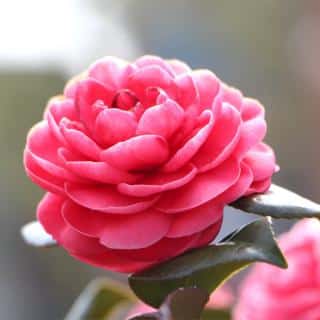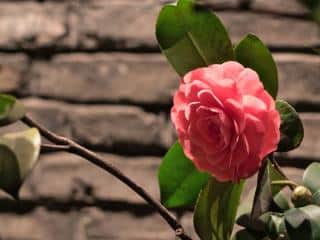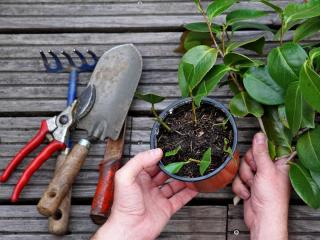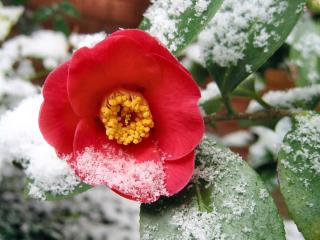

Camellia is a shrub with magnificent blooming in fall, winter or spring.
Key Camellia facts
Name – Camellia
Family – Theaceae
Type – flower shrub
Height – 3 to 16 feet (1 to 5 m)
Exposure – full sun, part sun, shade
Soil: light, well-drained – Foliage: evergreen – Flowering: fall → spring, depending on cultivar
It is recommended to plant camellias preferably in fall to ease root development and allow for better blooming the following year.
Planting camellia in the spring from plants purchased in containers is perfectly possible but they will require regular watering at the beginning.
 Camellias can do well in neutral soil but will always do best in acid soil.
Camellias can do well in neutral soil but will always do best in acid soil.
They like sun but must be protected from scorching. Part sun is often the best compromise.
Camellias will need regular watering during the first 2 to 3 years, especially if temperatures are high, in order to permit root development in the ground.
Potted camellia are a great way to decorate balconies and terraces, and also serve as a visual protection thanks to their evergreen leaves.
This is perfectly possible and camellias adapt very well to growing in pots. It is a perfect solution for those who have a terrace or a large balcony and who love camellias.
Even more so than when planted in the ground, potted camellias fear scorching sun and will appreciate light shade.
 Choose a good-sized pot with drainage holes.
Choose a good-sized pot with drainage holes.Camellias can stay 2 or 3 years in the same pot, but it will have to be changed after that to give the plant the space it needs to grow.
If the pot grows too large or heavy for regular repotting, an option is to go for topdressing.
Propagating your camellia isn’t very difficult. Cuttings are the way to go, though seeds, layering and grafting work well, too.
 In spring, take cuttings from new growth.
In spring, take cuttings from new growth.After about 2 months, it should start growing a bit: this is the sign the cutting has taken root. Keep in a pot and transplant to the ground late fall. Protect from the cold in winter.
Once settled in, the only care a camellia requires is watering in case of high temperatures and, optionally, pruning.
Camellias grow slowly, and do not necessarily require pruning.
Nonetheless, if you wish to balance the shape or reduce the size of your camellia, wait for blooming to be over.
Certain camellias are parts of a hedge, or are potted, and these must be pruned.
Take note that the flowering season of camellias can be in fall, winter, or spring depending on the variety.
It is important to know which season applies to your camellia, so that you don’t cut the branches just before that.
Camellias are heather plants, and like most heather plants they like cool, moist, and rather acid soils.
Regular but light watering is recommended if the soil surface dries out. This generally happens from May to August.
As for fertilizer, you can add heath plant fertilizer or camellia fertilizer in spring or fall.
Also, remember that pine bark mulch applied all year round can retain moisture, keep the soil cool, and as it breaks down increases soil acidity for camellias.
 Winter is what this shrub was made for! Some varieties and species even evolved to bloom during winter.
Winter is what this shrub was made for! Some varieties and species even evolved to bloom during winter.
It will resist freezing easily, and even snow won’t damage it. Evergreen leaves are leathery and thick and don’t easily get damaged.
Only in areas where winters are very cold will Camellia suffer from frost bite. In such places, remember to winterize your tree before the cold hits.
Camellias are rather sturdy and resist most diseases well. They may occasionally host scale insects or aphids.
This is often due to poor soil, and/or an excess of calcium in the soil. This is chlorosis.
This problem, called sooty mold, is often a secondary effect of other diseases or parasites such as scale insects. This fungus grows on honeydew that scale insects or aphids deposit on the leaves.
This flower shrub is famous for its generous blooming that can flower all year round depending on the species.
Originally found in Asia, its silhouette is defined as a bushy shrub, and its alternating leaves are leathery and oval-shaped.
They are usually planted as shrubs clumped together because they decorate the garden with brightly colored spots. They are also found stand-alone or in the middle of a flowered hedge.
Read also:
Mulching keeps weeds from growing, protects against the cold, and enriches the soil with natural nutrients.
Lastly, although camellia doesn’t like scorching sun, it also doesn’t like overly shaded venues.